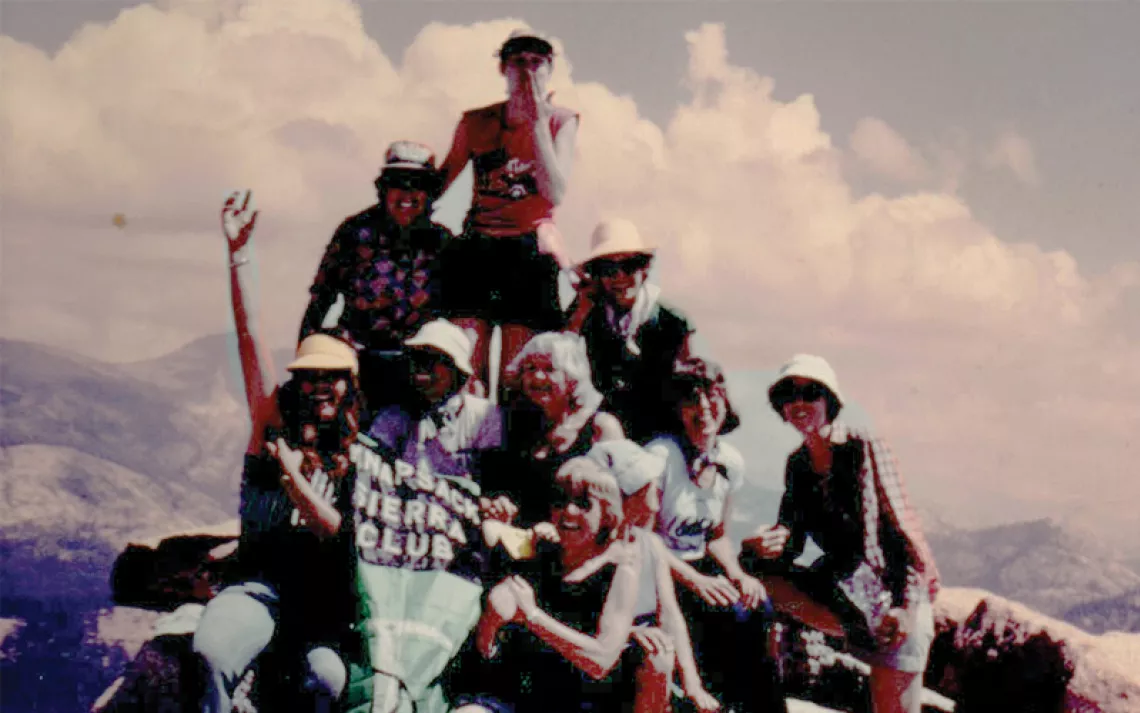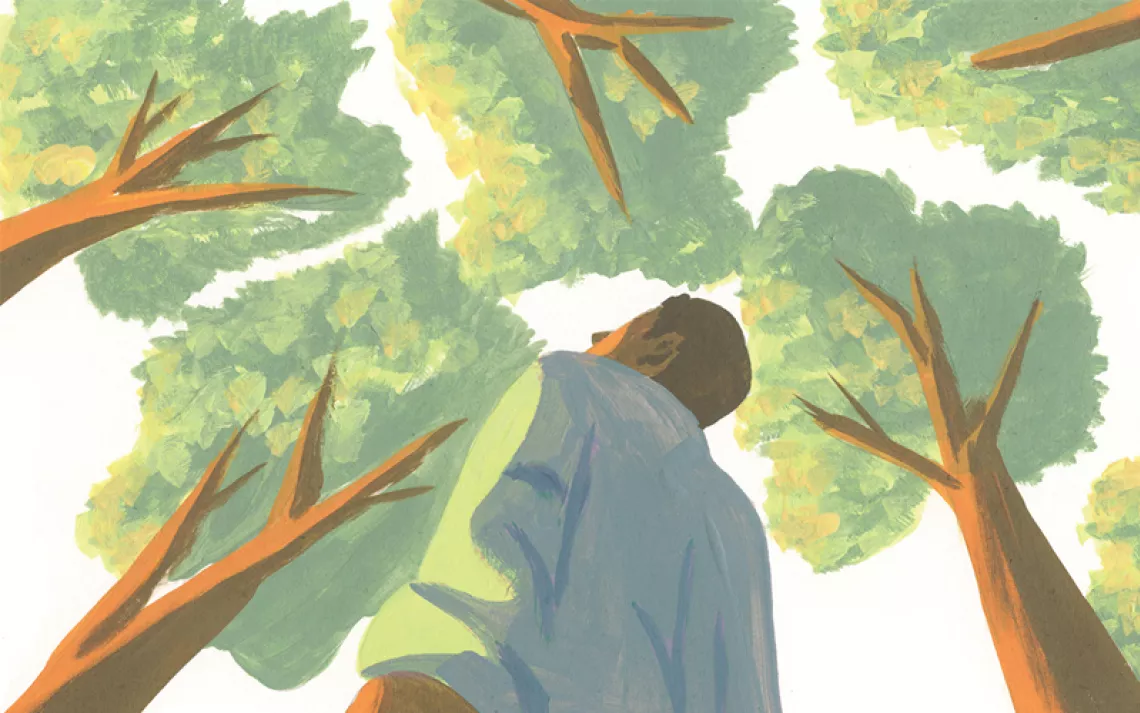As Low As You Can Go
Jim Malusa hit bottom on six continents, saving the drop into Death Valley for last

JIM MALUSA and his wife share a physiological affliction they've labeled "ants in our pants." Their honeymoon was six months on bicycles with no particular destination. A few years later in 1993, they biked through the mountains of Kazakhstan and Kyrgyzstan. "The pedaling made us happy," Malusa writes, "and the people saved our necks.... On our bikes, we were exposed to the winds, the wilds, the works, and this vulnerability pulled kindness from everyone."
From a cold 13,000-foot pass, the couple looked down on China's Takla Makan Desert. Its name means "You go in, but you don't go out." They descended from the chilling glaciers to the desert's hot Turpan Depression, the second-lowest place in Asia. This "hot and cheerful oasis of not-too-serious Muslims" convinced Malusa that down was better than up. So much better that he decided to visit the lowest point on every continent--at least those he could reach "without a submarine or a flashlight."
As he saw matters, this scheme had two golden attributes: "I wouldn't need insulated underwear, and I could ride my bicycle." Over the next six years, Malusa devoted a month's ride to each of "the pits": Australia's Lake Eyre, Asia's Dead Sea, Europe's Caspian Sea, South America's Salina Grande, and Africa's Lac Assal. He saved as his final pilgrimage the trip from his home in Tucson, Arizona, to Death Valley, the geographic nadir of North America.
Sierra picks up the story of that trip, pieced together from Malusa's Into Thick Air: Biking to the Bellybutton of Six Continents (Sierra Club Books, April 2008).
EARLY ON A SUNDAY MORNING in September, old Tucson is possessed not by cars but by dog walkers and doves. My bike carries a mere 15 pounds of gear, including a stove, pot, tent, sleeping bag, and copy of Mary Austin's The Land of Little Rain. It's quiet but not silent, and soon the wind comes up and kicks me in the rear, out of the city and across Avra Valley. It's a flat, straight cruise past drought-crippled hunches of mesquite, trees an optimist would call half alive. There are cacti, too, the jointed spindles of chain-fruit cholla, man-high and savagely spined.
Avra Valley is the Dust Belt, the creeping edge of Tucson. The pioneers live in rectangular ranch houses prettied up with split-rail fences or in double-wide Cavco trailers on lots scattered with sun-wasted tires and pocked with dust pits dug by overheated dogs. By the time I reach the western edge of the valley, flags of dust are rising from the flats. The wind on my tail makes short work of the 1,000-foot climb between the Coyote and the Roskruge Mountains, and I'm quickly beyond the reach of my hometown.
This is basin and range country, all the way to Death Valley. The ranges run mostly north-south, with topographic consequences for the east-west traveler: The road and I must thread our way around the mountains. I'm moving slowly by vehicular standards but quickly enough to entertain the illusion that it is the mountains that are moving. Mountains sink into the horizon, and mountains duck behind other mountains. What looked like a lone pyramid is actually a spine of rock 20 miles long, humped up in the center like a hissing cat. The ranges rise abruptly from the apron of eroded rubble that geologists call an alluvial fan. Locally, we're more apt to use the Spanish term bajada. It's the kindest habitat for the saguaros and foothill paloverdes, small stiff trees with a photosynthetic skin of smooth green bark.
I've driven this road a hundred times, but things look different from the seat of a bike carrying a sleeping bag with a cold beer tucked inside. For the next three weeks, I'll be living mostly outside, and, as Joseph Wood Krutch wrote in The Desert Year, "There is all the difference in the world between looking at something and living with it. In nature, one never really sees a thing for the first time until one has seen it for the 50th."
So true--but sometimes once is enough.
I catch the first whiff of moisture near the summit of the pass. Looking back over my shoulder, I see whirling snakes of dust on the leading edge of the storm, mixed with spouts of rain close behind. It's not a squall line nor a cloudburst but what looks like a vast and filthy waterfall pouring onto the horizon. The effect on my legs is immediate: faster. In the 40 miles between Avra Valley and the next town is a single rest stop with a picnic bench and ramada sunshade. I reach it just as the sky lets loose.
But the wind is cutting so hard that the ramada isn't enough. The horizontal rain forces me to crawl under the concrete bench and build a little upwind barrier with my bike and cargo bags.
And still it finds me. Mesquite leaves stripped from the trees snag in the bike spokes and tremble in the gale. So do I, despite my raincoat. It's not the silver whips of cold rain. It's the sound of the aluminum roof groaning as it twists and warps.
The rain quits after an hour, a long time to feel stupid and afraid. The wind still blows, flattening the tussocks of yellow grasses and taking me over the pass. I've got in mind a certain dirt track to a campsite I'd imagined many months ago.
I find it: freshly washed sands and well-fed saguaros. A slice of blue is wedging under the clouds from the south. I don't trust it and set up the tent as close as possible to the only windbreak, a scrap-heap ridge of busted granite. Dinner is a can of pork and beans. The wind rolls in like heavy surf with waves that pour over the ridge and bow in the side of the tent until the fabric is three inches from my nose. When the rain returns, there's really nothing to do but to stare at the ceiling and think: only 665 miles to Death Valley.
A FEW HUNDRED OF THOSE MILES down the road, Malusa reaches Nevada.
There are few things better than waking to a sky streaked with a whiz of cirrus, getting on a bike, and aiming for a small notch in a big mountain.
The road loops south to find a break in the sandstone ramparts, a detour that is accelerated by the passing of a racing bicyclist with a scorpion on his jersey. With a flick of his wrist, he invites me to catch his slipstream.
The next 20 miles are up a canyon in the dense shade of cottonwoods, across a mile-high mesa of small fragrant pines weeping yellow sap, and down a bajada scattered with limb-waving Joshua trees like boxers with spiked gloves. Then the big plants fade away, and the last 20 miles cross a plain of creosote bush, along a road as straight as a kite string in a gale. It's the sort of monotony that should drive me nuts but doesn't. The primary fault of this desert--no trees--is also its virtue. With views to a horizon only slightly refracted by the ripples of heat, the eye is drawn to the mile-wide blank in the center of the valley, a patch of no plants whatsoever. It's a playa, a dry lake, the first since leaving Tucson and the shape of things to come.
The road continues into the town of Pahrump, a pair of mega-groceries with acres of parking for the 35,000 people in white houses and trailers. Propane and septic-pumper trucks cruise a grid of gravel roads. It's the sort of town where folks claim to be escaping the big city--and then build their own, the spawn of Las Vegas.
Pahrump has casinos, but I've had my fill. Pahrump has an instant golf course of emerald sod and Mediterranean pines, but I've only caddied, never golfed. Pahrump has a billboard featuring a hungry blond with arms raised above the swell of her chest, a bosom strategically cut off by the bottom of the billboard. "Venus," it says--and suddenly I realize that this is my last day in the only state to legalize prostitution.
An arrow on the billboard points down to a little home beneath; it wears its own sign, "Adult Entertainment Information." Of course I brake to a stop. A five-second examination of my soul finds it somewhat south of its usual location but still committed to my wife.
Inside, a lady with a French poodle greets me. Pert. Nice eyes. But she's at least 60, raising the possibility that the prostitutes have joined the Pipefitters Union Local 211 and this lady has seniority. She's doing a crossword while the TV shows Kabul burning.
"Is there something you need?"
Suddenly shy, I mumble that I'm just passing through.
"Here's our souvenirs and novelties."
A glass case with dusty coasters and Venus bumper stickers. That's it?
"That's it."
I slip out of town at dusk, never giving Pahrump a chance. Riding west, I look for the other Venus but fail to find her light. I do find an arroyo to call my own. The horizon is humped with hills, but not until the light of morning do I discover that they're built of cruel limestone, almost but not quite black.
On the back page of my journal, under the heading "Cheering descriptions of Death Valley," I've collected the impressions of others over the past century. Pit of Horrors. Creator's Dumping Place. The Smoking Furnace. Jaws of Death.
Yet it's not death calling this morning, but the sweet trill of the phainopepla, a silky black flycatcher with a crest like a Roman helmet.
TWO DAYS LATER, Malusa wheels down to the floor of Death Valley.
The Furnace Creek Inn is three stories of adobe and stone under a red tile roof, buried in palms and gardens. When I pedal up and ask a man coming out if they serve breakfast, he looks at his watch and says, "It's 12:15." He checks me out. The verdict: Safe, although it's clear I just descended a vertical mile on my bike. Wondering, he is, where I came from.
Likewise.
"I'm from Berkeley. I had a motorcycle dealership, but I sold it--to see the world."
Ronald Ware is not young, but his black skin is nonetheless wrinkle free. He wears a neat checkered button-down shirt, bluejeans, black leather shoes, white socks. We stand in the shade of a palm. I cannot resist asking, "Of all places, why Death Valley?"
"I was traveling through Europe, and I was in Istanbul when I had this moment, this ... epiphany. I'd gone to the bazaar, to the great mosques, when I realized that most of all Istanbul was a big noisy city crowded with people. I found myself thinking: I could have found this in San Francisco.
"And I said, why am I in Istanbul when I don't even know my own country? So I set out and found myself here, and I love it. The space, the quiet. I'm 61, and I had no idea!"
Ware also loves desert driving. "I can go a half hour without seeing another car."
The nomad's pleasure. "Treeless spaces uncramp the soul," declared Mary Austin a hundred years ago. She liked to urge her horse along at a "jigging coyote trot" through her beloved treeless space, the Mojave Desert of puckering summer droughts and zinging winter freezes. This desert.
Soon I've yakked and idled away my chance to reach the low point today. I spend the night in a canyon near Furnace Creek, munching pistachios and reading Austin's account of a prospector who'd camped out so often that he "had gotten to the point where he knew no bad weather, and all places were equally happy so long as they were out of doors."
In the morning I head back to the inn for breakfast. It's just me and one other diner and Betty the hostess. She wears a bright enameled flag brooch. "I never thought I'd like living in a trailer in Death Valley, but I love it. Come by and put your feet up on the coffee table--I don't care."
I'd love to, but I'm going out to Badwater for the night.
"For the night? I met a hiker who slept out there, and he said it was so quiet that he could hear the blood pumping through him. Badwater sure is a pretty place, but I wouldn't want to sleep listening to that! Too quiet for me, way down in that hole where there ain't no noise--uh-uh."
She deftly refills my water glass and takes a seat at the table.
"I want to hear a little something--a cricket or a frog or even just the sound of a car passing, not all squealing but just the sound of its tires, something to remind me that I'm not all alone."
That afternoon I leave Furnace Creek, all alone. The valley bottom, which from Dante's View appeared to be a perfectly level salt pan, is not. What looked smooth is actually blisters and little towers of salt. The farther south I ride, the closer they approach the road, until the tongue of salt reaches almost to the pavement and the crumbling mountain. Then the final drop, and I can go no lower. "Badwater," says the sign, "-282 feet": the lowest point in North America.
It's rough riding across the foot-wide polygons whose borders are thickly ridged or wrecked in heaves like sea ice. I walk the bike west, toward the center, occasionally turning to watch the road and parked cars diminish with distance. I pass the last tourists. The salt floes become much broader, three to ten feet across, with two-inch-high ridges between. The snowy surface is built of thousands of stalagmites less than a half-inch tall that crunch underfoot with a sound like knuckles popping. I could ride now, but even walking the bike leaves a track. So I carry it, not wanting to leave a mark I myself wouldn't want to find.
The sun goes down in flames without a sound. It's a good thing Betty the hostess isn't here, fidgeting in the silence. Quiet, I suppose, reminds her of death. But to be able to "hear the blood pumping" is to hear life, your own life.
After dinner and a beer, I light my pipe and watch the smoke laze in blue reefs around my bag. No wind. When I stand I feel a thermocline developing: It's colder at my feet than my head. All I need now is data: My thermometer says it's 75 at my toes and 82 at eye level.
At 8 P.M. the moon is just a grin on the western horizon, two hours behind the sun. The cool light catches the ridges of salt that encircle my camp and extend to the mountains. A very crisp scene: the perfectly flat, pure white floor of the valley, the black masses of the mountains beyond, rising 6,000 feet to the east and 11,000 feet to the west.
There goes the moon. The earth is spinning, and I'm pinned by gravity and good fortune. I think of the Seven Summits and the urge to leave Mt. Everest not long after you arrive--and how different this is, lying on a glazed sea of salt.
 The Magazine of The Sierra Club
The Magazine of The Sierra Club



